As markets closed last week after setting fresh all-time highs, the near-term outlook remains cautiously constructive but demands more tactical positioning. Earnings season is ramping up, and early reports from sectors like consumer staples, airlines, and semiconductors have reinforced the bullish narrative, helping propel the to new records.
However, technical indicators, including stretched RSI levels and flattening MACD histograms, signal that short-term momentum could reach exhaustion levels, particularly in mega-cap growth stocks.
Investors should be prepared for rotational opportunities as positive earnings momentum starts filtering into under-owned sectors, such as financials, industrials, and select cyclicals, which are still trading below their relative highs. Key earnings reports from large banks dictated last week’s action, as did updated inflation data and ongoing concerns about the current battle between the White House and the Fed.
With these catalysts in play, investors should consider trimming profits in overextended positions, raising modest cash allocations of 5–10%, and tightening stop-loss orders on high-beta trades. Maintaining tactical flexibility will allow investors to capitalize on sector rotation opportunities, particularly if earnings from financials or industrial companies exceed expectations.
While the market remains in a confirmed uptrend, narrow breadth and overbought technical conditions suggest a more selective and risk-managed approach is prudent as we head into the last weeks of July.
Technical Backdrop
- S&P 500 Index remains nearly 10% above its 50-day moving average and close to 9% above its 200-day moving average. Technical indicators like RSI and MACD point to overbought conditions, with momentum beginning to stall.
- Tech leaders like Nvidia (NASDAQ:) hold strong uptrends and are comfortably above short- and long-term moving averages. However, broader market participation is weakening, and retail involvement is declining.
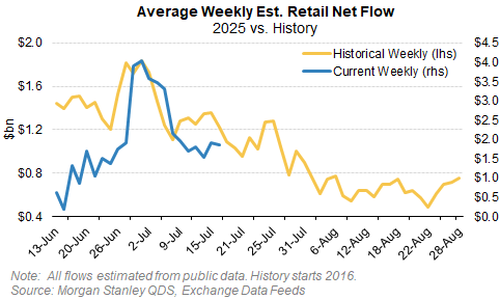
A negative divergence occurs when the market tries to push higher, even as momentum and relative strength weaken. Such a divergence is beginning to develop and is worth paying attention to. While this is not an imminent threat, historically, these negative divergences tend to precede short-term corrections.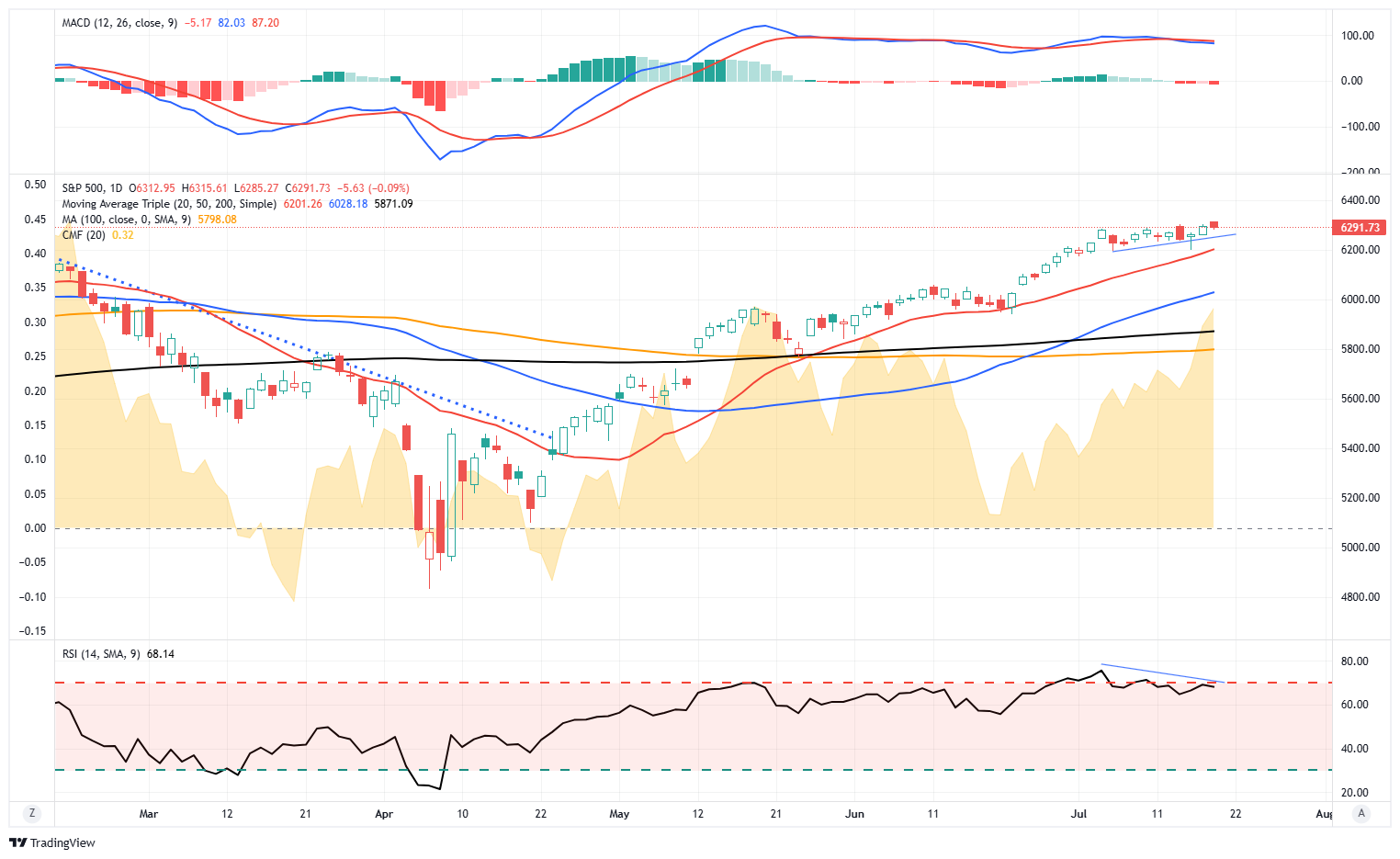
- Risk factors remain mostly the same.

Key Catalysts This Week
As markets head into the final stretch of July, several important catalysts will drive market direction this week. The primary focus will be earnings season, which kicks into high gear.
- Earnings season: High-profile reports from major consumer, tech, and industrial names. Companies like Coca-Cola (NYSE:), Verizon (NYSE:), Alphabet (NASDAQ:), Tesla (NASDAQ:), Intel (NASDAQ:), and General Motors (NYSE:) will provide crucial insight into consumer demand and corporate profitability. Strong reports could help expand market breadth, while any high-profile misses, particularly from mega-cap tech, could trigger sector rotation.
- Federal Reserve policy signals will remain in focus. The market is split on whether the Fed will cut rates at this week’s meeting. Governor Waller’s recent comments supporting a cut have increased market speculation, but mixed views within the Fed suggest policy uncertainty remains high. Several Fed speakers are scheduled this week, and markets will closely monitor their remarks for clues on rate direction into the fall.
- U.S. Leading Economic Indicators will provide a broad gauge of economic momentum, helping investors assess whether the soft-landing narrative remains intact or if growth concerns are building.
- Fed Chairman Powell will make public remarks that could provide critical clues on the Fed’s evolving stance on rate cuts. Markets will be hyper-sensitive to any shift in tone, especially with the July FOMC meeting approaching.
This week will be pivotal for balancing economic resilience and softening growth. Stronger data could push yields higher and extend the equity rally, particularly in cyclicals and financials. However, any deterioration in the leading indicators, labor market, or housing data could reignite concerns about economic slowing and trigger defensive rotations.
Central bank commentary, particularly from Powell and the ECB, will be closely monitored for signals on policy direction. Investors should remain tactically flexible, focusing on earnings reactions while keeping an eye on these key data points for broader market cues.
High-beta positions may warrant tighter risk controls, while maintaining some dry powder could allow for opportunistic rotation into sectors showing relative strength following the data releases.
Overall Risk Outlook: Risk levels remain elevated. While earnings and disinflation are supportive, stretched valuations and technical exhaustion argue for more defensive positioning in the short term.
Company Buybacks Are Surging
We recently published our , which began with the major banks on Tuesday.
Over the last few months, according to data from S&P Global, the Q2-2025 earnings estimates have declined from $234/share in the original March 2024 estimate to $220/share as of June 15th. That $14 drop in estimates is partially due to the impact of tariff concerns on corporate outlooks.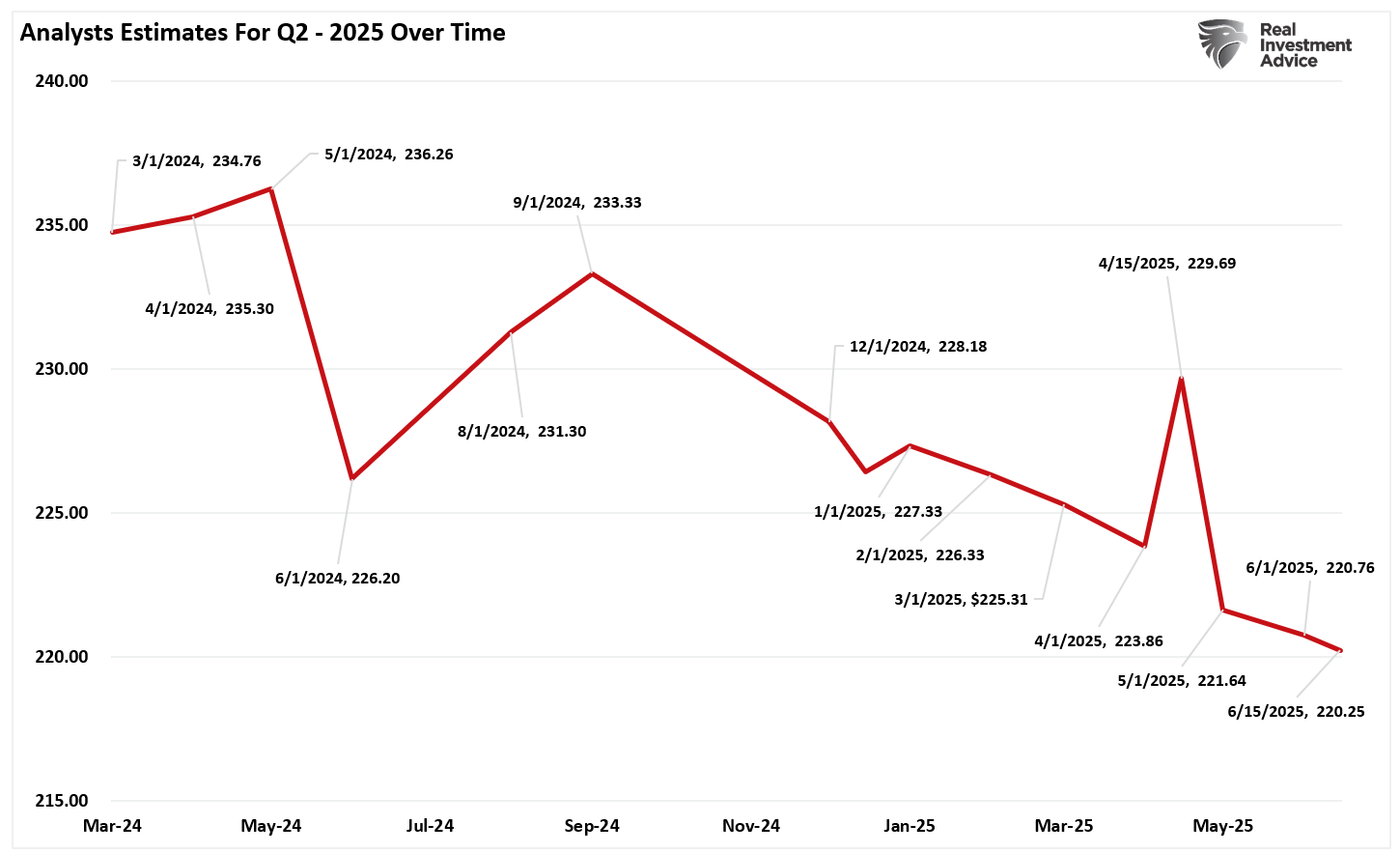
According to FactSet:
“Heading into the end of the quarter, analysts have reduced earnings estimates for S&P 500 companies for the second quarter more than average. However, the percentage of S&P 500 companies issuing negative earnings guidance for the second quarter is less than average.
As a result, estimated earnings for the S&P 500 for the second quarter are lower today compared to expectations at the start of the quarter. In addition, the index is expected to report its lowest year-over-year earnings growth rate since Q4 2023 (4.0%).
In terms of estimate revisions for companies in the S&P 500, analysts have lowered earnings estimates for Q2 2025 by a larger margin than average. On a per-share basis, estimated earnings for the second quarter have decreased by 4.1% to date. This decline is larger than the 5-year average (-3.0%) and the 10-year average (-3.1%) for a quarter.”
We also see the same degradation in estimates in Goldman Sachs’ recent assessment, where Q2 is expected to generate only a 4% growth in earnings. Unfortunately, most of that earnings growth comes from just a handful of stocks in the index (hint: The Magnificent 7).
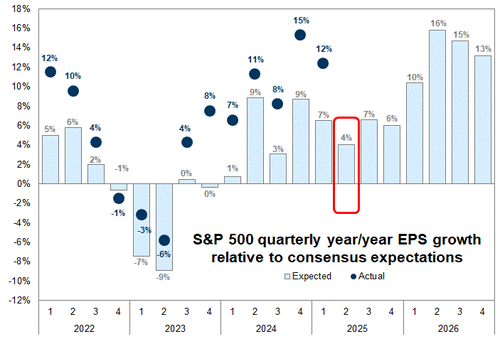
According to Goldman Sachs, what matters for investors is that the expectations bar is low (as noted down to 4% from 12% in Q1), and it will be cleared. At a high level, the focus will be on the impact of tariff policies on margins, sales, and investment spending.
Here is the rub. Goldman suggests that the current expectation is that consumers will take the brunt of the tariff cost burden (economists think they will absorb 70% of the cost). However, that may not be the case as seen in the latest inflation reports.
If that is the case, corporate margins could have a more severe impact. Still, we won’t know that impact until we get further into earnings season and hear from companies like Apple (NASDAQ:) with a significant exposure to international sales.
Goldman does make an interesting point:
“Of course, with inflation not budging, the implication is that consumers haen’t borne the brunt of the tariff cost burden, as in any of it, and since corporations aren’t issuing profit warnings, the conclusion is simple: foreigners are paying the tariffs, just as Trump said they would.”
We will see if that continues, but the tariffs have not been the disaster Wall Street expected. Nonetheless, the negative revisions are tied to concerns over tariffs under the current Administration, and the lack of finalized “trade deals” keeps forward estimates in flux.
However, as we move into Q3 and Q4 of this year, the expectations are for a sharp increase in earnings in 2026, as shown.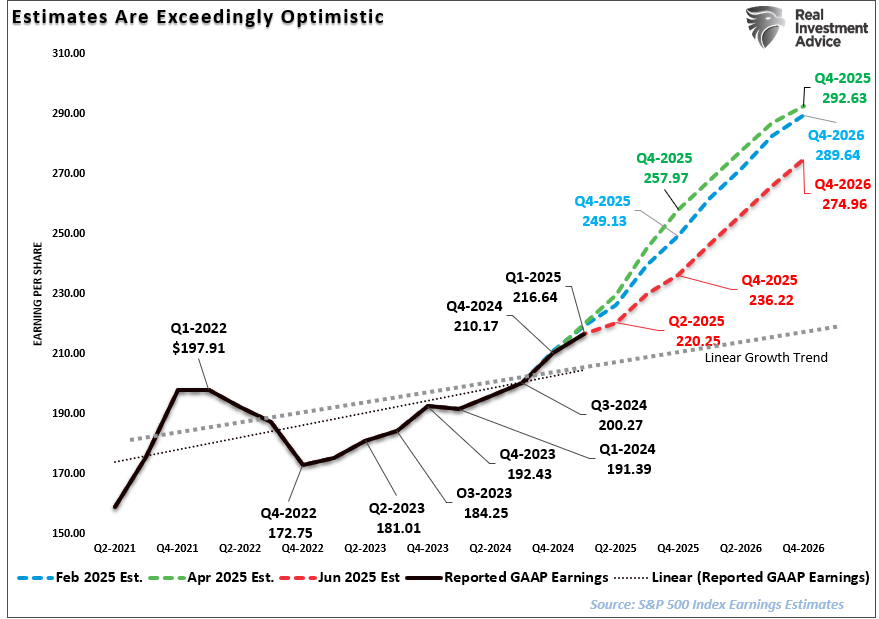
That surge in earnings will largely be predicated on stronger economic growth and a pickup in consumer spending. Although right now, with consumer delinquency rates on the rise, elevated, and consumer credit more restrictive, there is a significant risk of future downward revisions
However, while earnings estimates are likely overly optimistic, one key support for the market and earnings remains company buybacks. Over the last two months, announced and actual company buybacks have surged. Notably, company buybacks are at a new record and expected to exceed $1 trillion by the end of 2025.
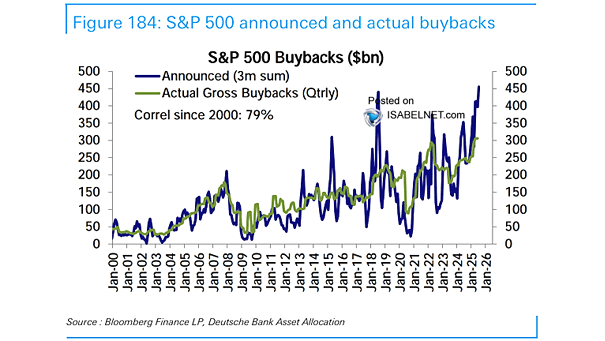
Unsurprisingly, that surge in company buyback activity, a significant market participant, supports the markets during periods where company buybacks are most active.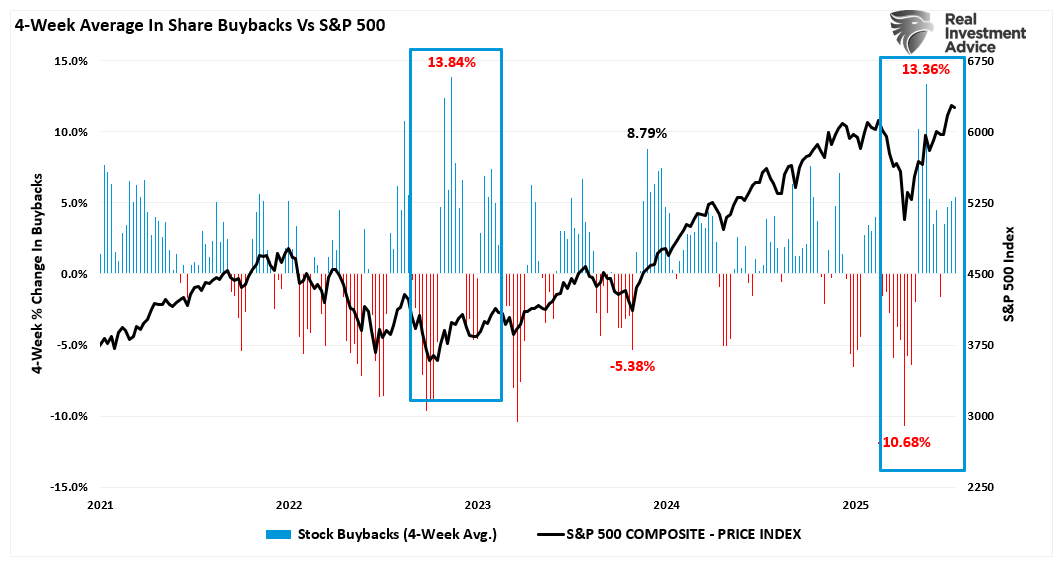
While the Q2 2025 earnings season has started under a cloud of lowered expectations, driven by tariff concerns, slowing global growth, and reduced corporate guidance, the market remains buoyed by technical factors and record company share buybacks.
Earnings growth, though positive, is increasingly narrow and concentrated in a few large-cap names, raising questions about the broader market’s underlying strength.
Ultimately, while corporate buybacks continue to provide critical market support in the near term, the sustainability of the earnings rebound will depend on a healthier economic backdrop, improved consumer balance sheets, and greater clarity on trade policies in the months ahead. However, we remain more skeptical of those outcomes.
Nonetheless, the market keeps triggering more bullish scenarios.
Nasdaq’s Golden Cross
The “Golden Cross,” where the 50-day moving average moves above the 200-day, is flashing again for the . This is the fourth time since 2018 that markets have seen this technical signal, with previous instances in 2019, 2020, and 2023 leading to strong equity rallies.
The latest cross, occurring in late June 2025, has reignited bullish sentiment, with many market participants suggesting we could be in the early stages of another sharp market melt-up.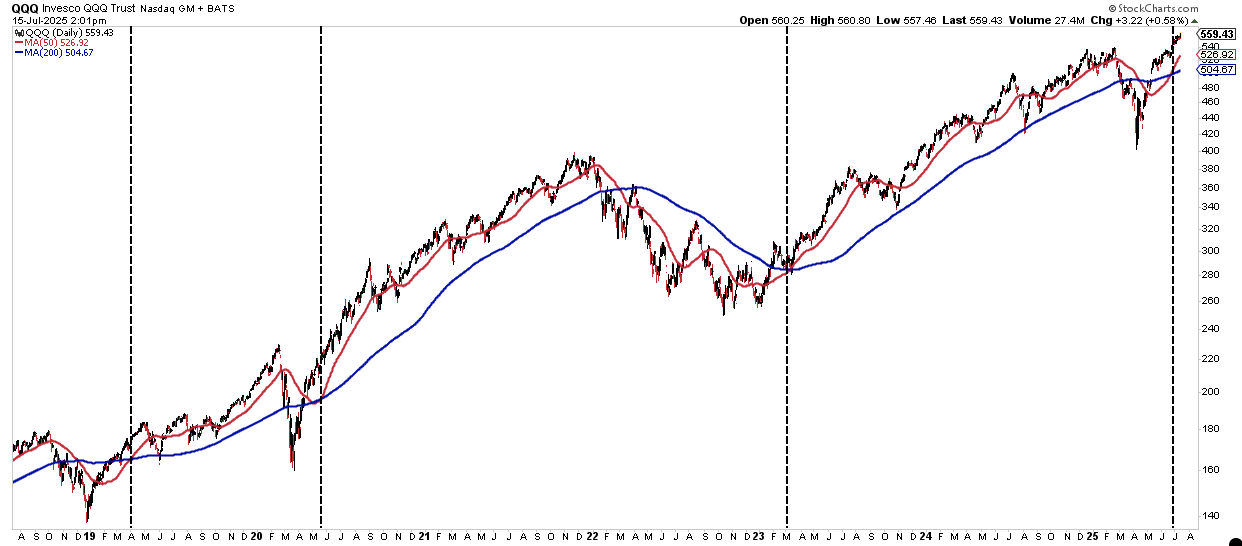
This signal carries so much weight psychologically as well as technically. A “Golden Cross” often signals a positive shift in market momentum, indicating that short-term sentiment has turned decisively bullish. Similar technical setups have coincided with periods of robust gains, driven by investor enthusiasm and broader market participation.
Today’s market shows similar characteristics: volatility remains subdued, options dealers are tilted toward positive gamma positioning, and liquidity conditions are supportive.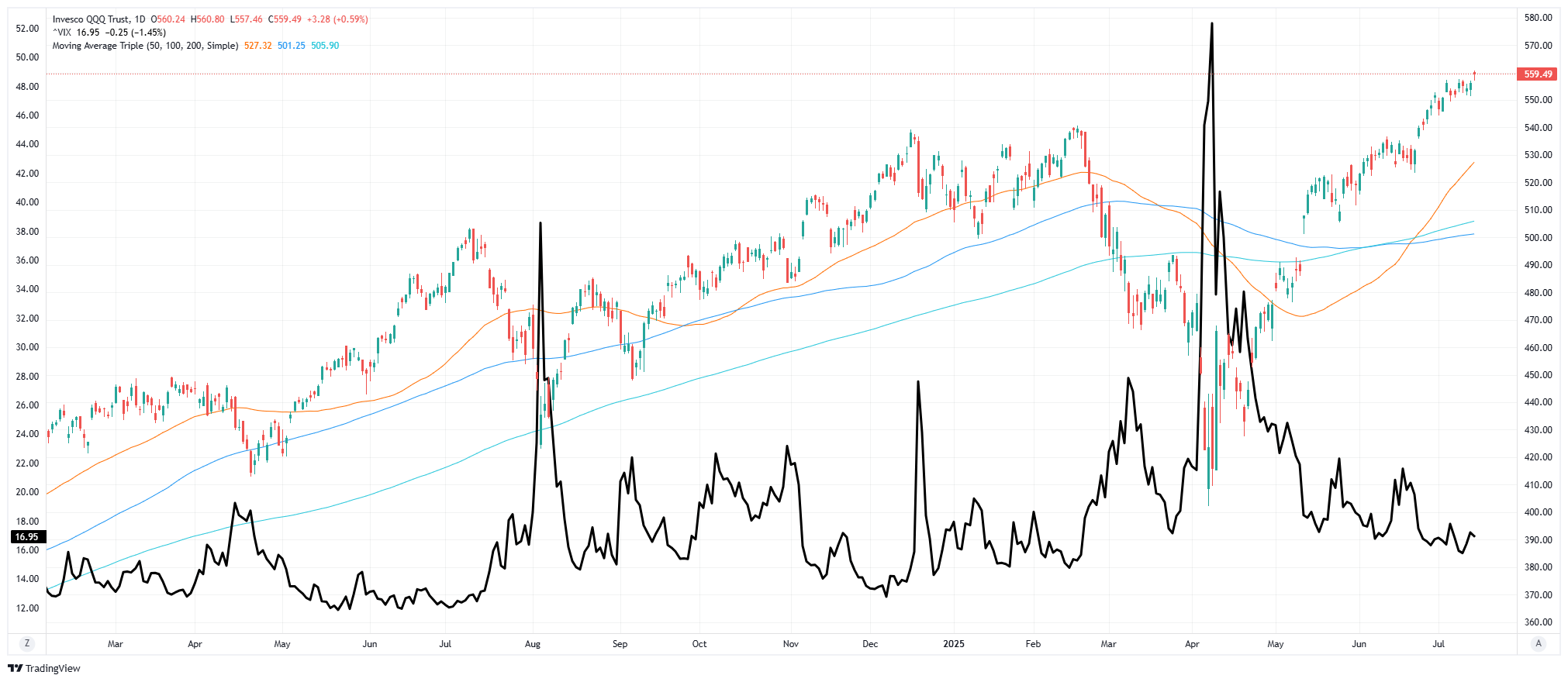
However, investors must ask whether fundamentals align with these technical tailwinds. In prior rallies, earnings growth, low interest rates, and easy monetary policy provided strong fundamental support.
This cycle looks different. Inflation remains sticky, interest rates are elevated, and global economic growth faces numerous headwinds, from weakening consumer spending to trade tensions. These challenges create a risk that the rally is driven more by technical momentum than by improvements in the real economy.
This doesn’t mean the rally can’t continue, but it does suggest a need for caution. The ‘Golden Cross” reflects a shift in sentiment and trend, but it does not guarantee future gains. Historically, major market tops can also form after such signals, especially when coinciding with deteriorating macro conditions.
In the short term, markets may continue to grow as technical traders and algorithms chase momentum. However, investors should remain alert to earnings results and macro data in the weeks ahead. The rally could have legs if corporate profits rise and inflation shows signs of easing.
If not, this “Golden Cross” could mark a temporary high rather than a sustained breakout. Momentum may be back, but sustainable gains require more than technical signals.
Portfolio Tactics
Building exuberance in the market is part of the “bull market” process. However, when that enthusiasm reaches more extreme levels, it is also a contrarian signal often ignored by investors. The consequences of such are typically not conducive to wealth-building practices.
The problem with the above analysis is that the “timing” of such a “mean-reverting” event is always tricky. Momentum in the market is difficult to stop, but it tends to do so quickly when it reverses.
Since we never know the timing, we must rebalance risk accordingly. Last week, we:
- Reduced our bond duration slightly, with an overweight to shorter-duration bonds to benefit from future rate cuts.
- We also increased our holdings in mortgage-related stocks and ETFs for the same reason.
- We took profits in some of our portfolio’s most egregiously overbought holdings and added to some positions that were catching rotational flows.
Furthermore, we continue to suggest following the basic portfolio risk control guidelines.
Core Positioning:
- Maintain core equity allocations but trim exposure in extended sectors such as large-cap tech.
- Focus on high-quality, fundamentally sound companies showing strong earnings momentum.
Tactical Adjustments:
- Raise cash levels slightly
- Rebalance positions back to target weightings.
- Sell laggards that failed to perform during the rally from the April lows.
- Add hedges to portfolios as needed to reduce overall portfolio volatility.
- Add volatility protection through short-term Treasury bonds.
- Remain selectively long AI and tech leadership, but hedge tail risks as breadth weakens.
- Add selective hedges using short-term puts on the S&P 500 (SPY) to protect against near-term pullbacks.
Allocation Mix Suggestion:
- 60% Core Equity (tilted towards momentum names showing earnings beats)
- 20-25% Tactical (short-duration bonds, defensive positioning (value stocks), or hedges)
- 10-15% Defensive Assets (cash or cash equivalents)
Investors should stay flexible with equities near record highs, stretched technicals, and rising rates. This is an environment to remain opportunistic but disciplined, buying pullbacks in key areas of strength while using hedges to mitigate downside risk. Capital preservation should be at the front of mind alongside tactical positioning as the market navigates earnings and shifting macro narratives.

Market Statistics & Analysis
Weekly technical overview across key sectors, risk indicators, and market internals
Market & Sector X-Ray: Overbought But Correcting
While the market traded flat primarily this past week, the sloppy trading action did reduce some of the more extreme overbought conditions from last week. However, even with the mild reversion, more work will likely be done. Technology and Discretionary, along with the S&P 500, remain very overbought, but , , , and Bonds are oversold. A sector rotation is likely at some point over the next month.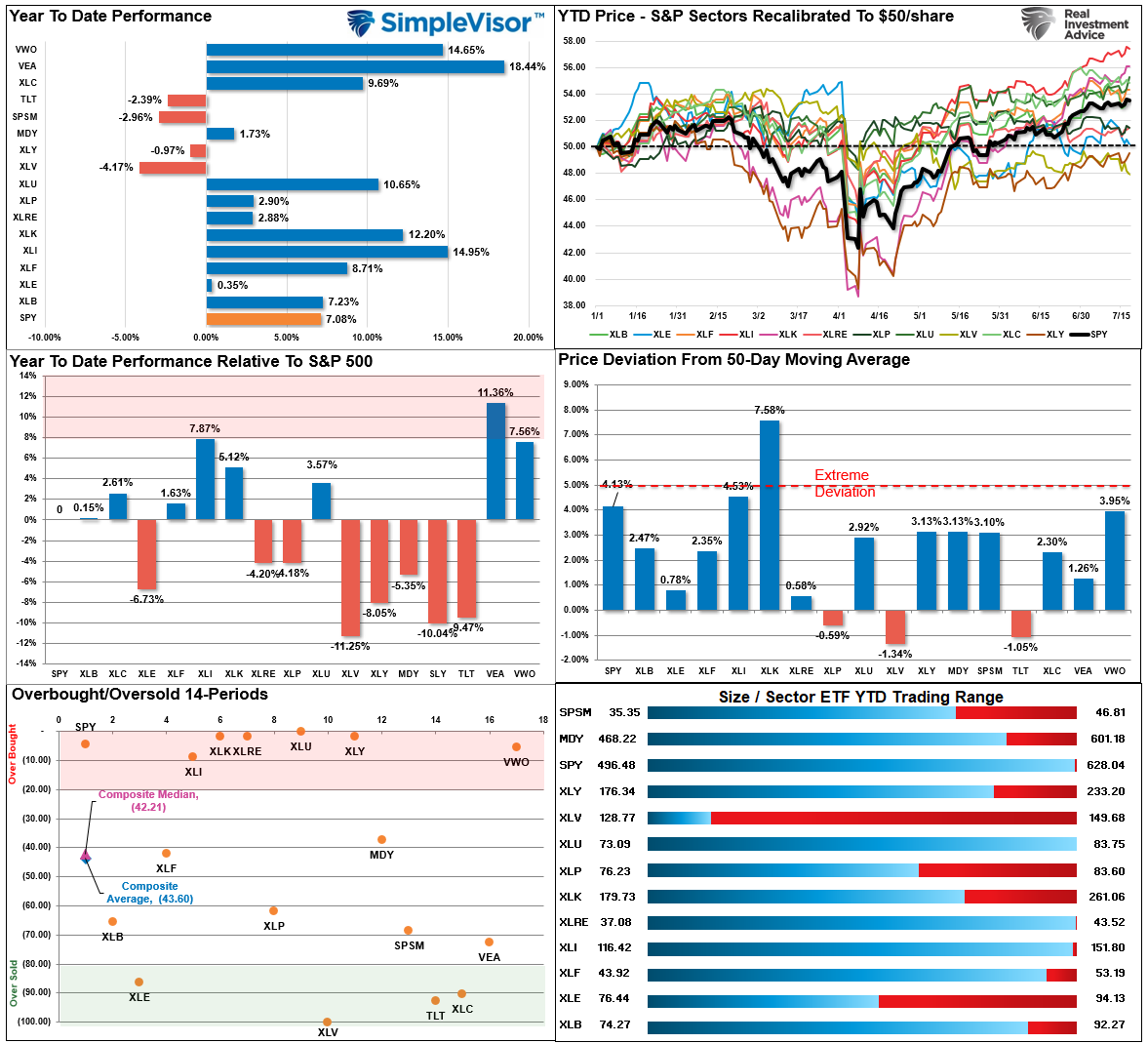
Technical Composite: 89.01 – Very Overbought, Risk Rising
Markets are pushing into more overbought territory, and pullbacks to support are likely.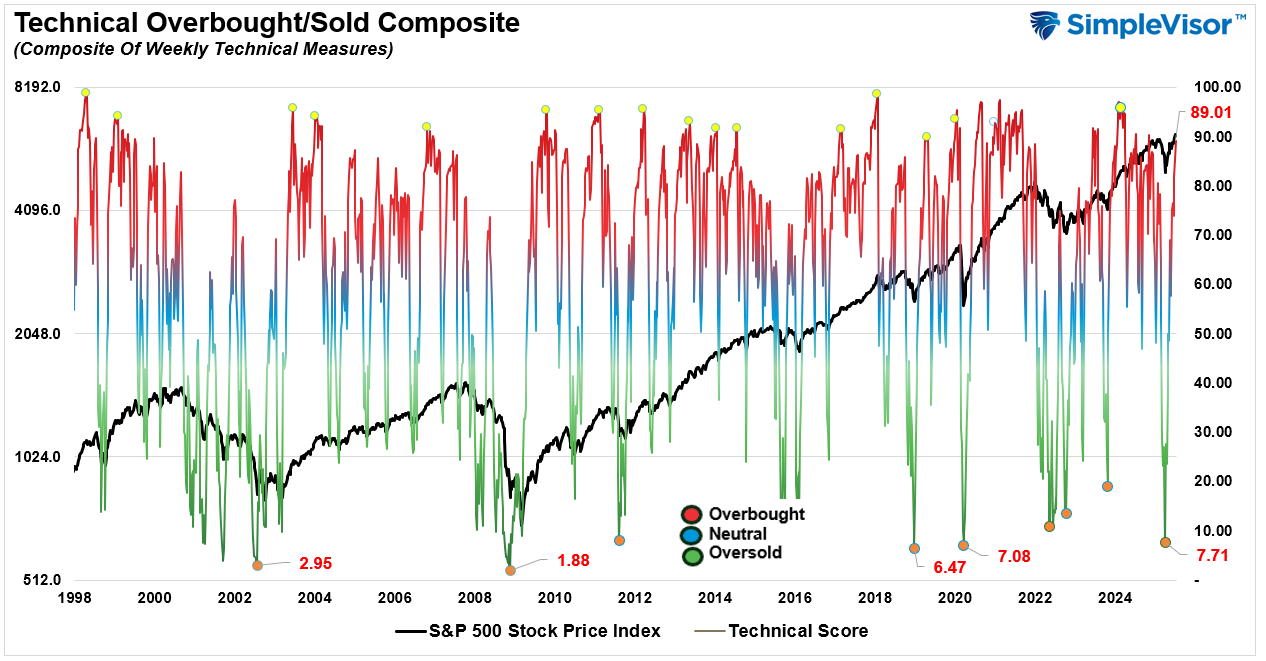
Fear/Greed Index: 76.40 – Extreme Greed, Risk Warning
Investor psychology and risk appetite did pull back slightly last week, but remain in extreme greed territory. Current readings are at levels that suggest risk management is more important than chasing further gains.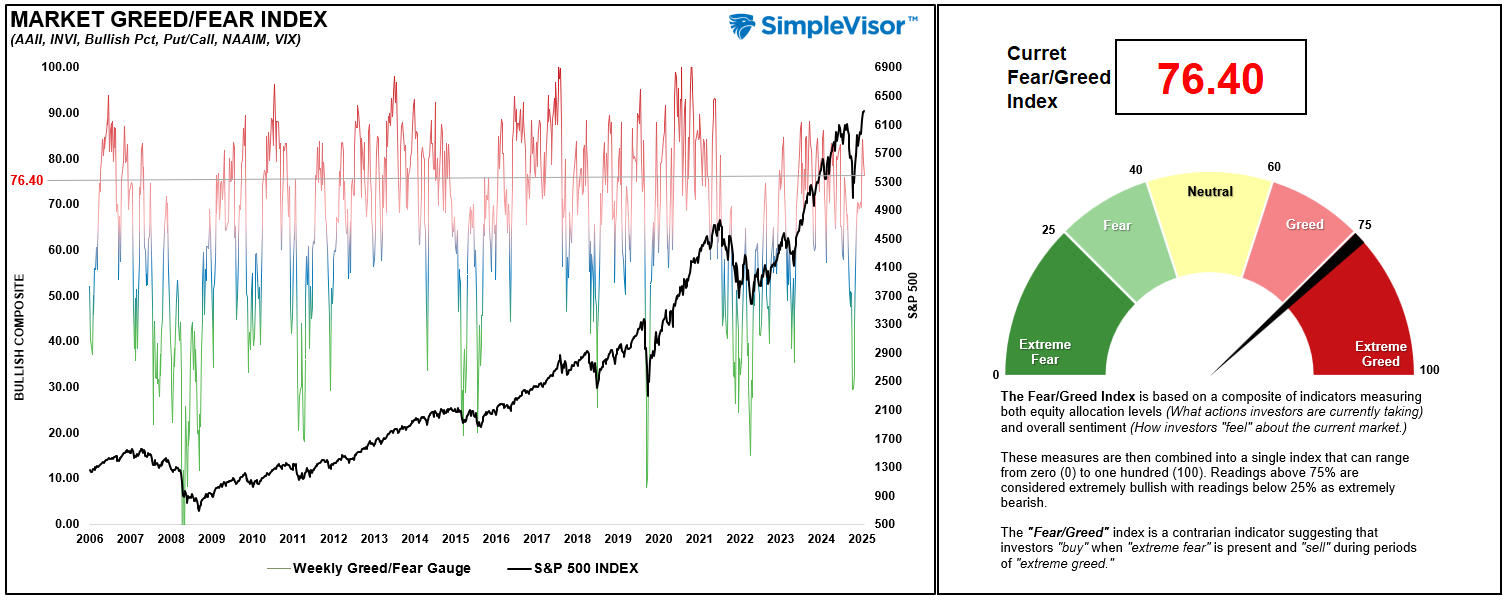
Relative Sector Performance
Healthcare, Materials, and Energy underperformed the most last week as investors chased Transports, Industrials, and Technology. With the leaders in more extreme overbought territory, investors should eventually expect a correction and a rotation back to more defensive sectors.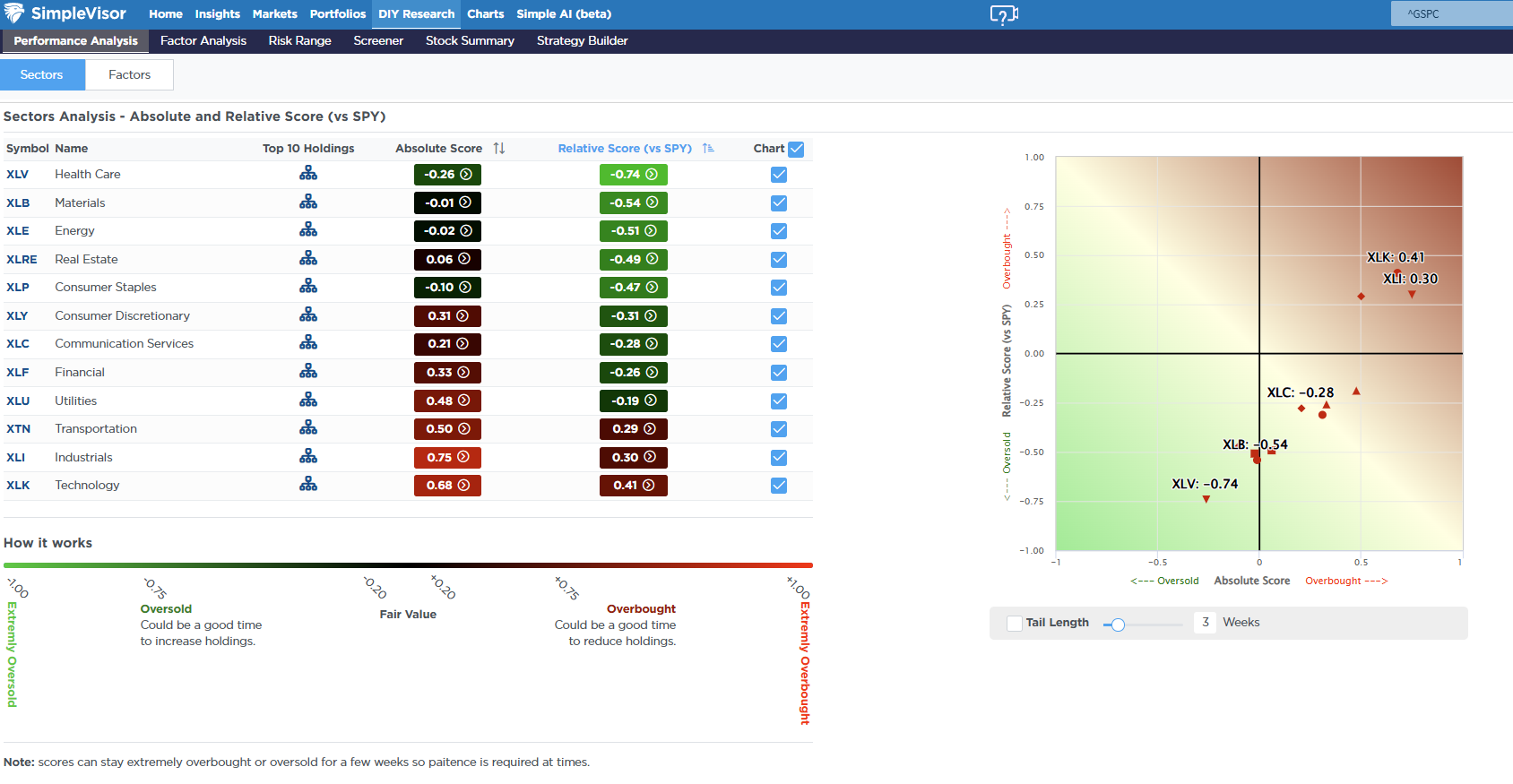
Most Oversold Sectors
Healthcare is currently the market’s most oversold sector, which could catch inflows from a risk-off rotation. , , and are presently the most oversold and provide an interesting opportunity if the market begins searching for more defensive names.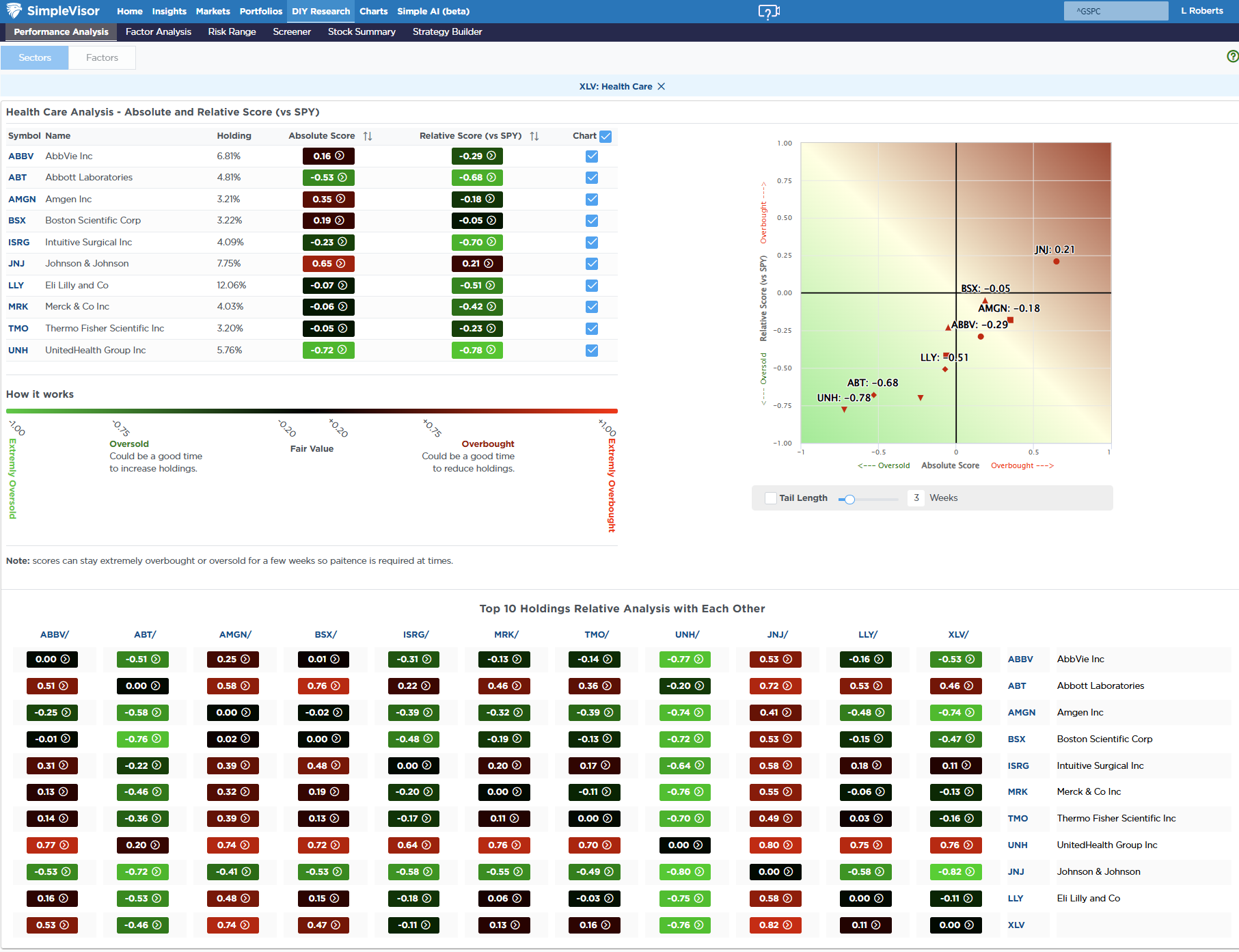
Sector Model & Risk Ranges
As noted last week, many markets and sectors have triggered bullish weekly moving average crossovers, increasing from just seven a few weeks ago to 15. That continued improvement suggests that the risk of a much deeper market correction is fading; however, that does not exclude 3-5% corrections along the way. is trading well outside its monthly risk range, and Bonds are trading well below.
Technology and Industrials are very deviated from their long-term moving averages as well, which suggests some profit taking would be wise. A setup for a “risk-off” rotation from offensive to defensive sectors seems to be building.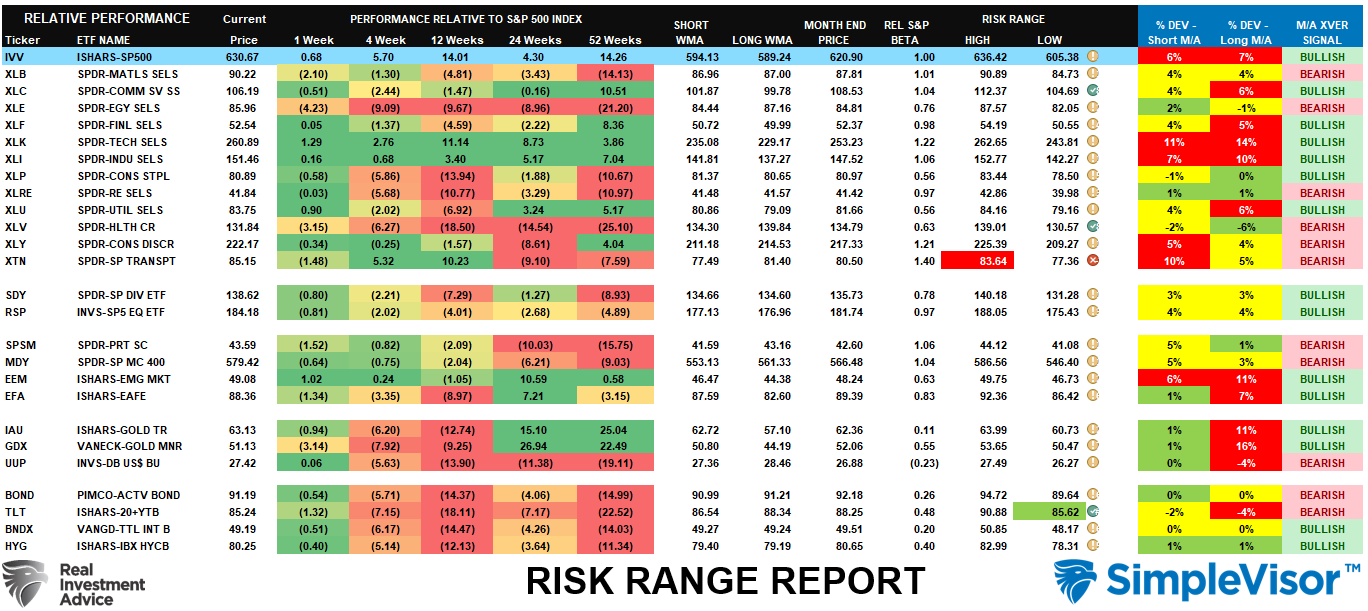
Have a great week.
